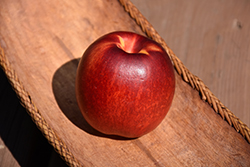Arctic Star Nectarine*
Prunus persica var. nucipersica 'Arctic Star'
* This is a "special order" plant - contact store for details
Height: 15 feet
Spread: 15 feet
Sunlight:
![]()
Hardiness Zone: 6a
Description:
A low chill cultivar, featuring rich red fruits with sweetly flavored, juicy snow white flesh; freestone; stunning pink flowers in spring on a low, spreading habit; susceptible to late spring freezes and disease, needs full sun and well-drained soil
Edible Qualities
Arctic Star Nectarine is a small tree that is typically grown for its edible qualities, although it does have ornamental merits as well. It produces crimson round fruit (technically 'drupes') with hints of buttery yellow and white flesh which are usually ready for picking from late spring to early summer. Note that the fruits have hard inedible pits inside which must be removed before eating or processing. The fruits have a sweet taste and a juicy texture.
The fruit are most often used in the following ways:
- Fresh Eating
- Cooking
- Baking
- Preserves
- Canning
Features & Attributes
Arctic Star Nectarine is bathed in stunning clusters of fragrant pink flowers along the branches from late winter to early spring, which emerge from distinctive rose flower buds before the leaves. It has dark green deciduous foliage. The narrow leaves turn yellow in fall. The fruits are showy crimson drupes with hints of buttery yellow, which are carried in abundance in early summer. The fruit can be messy if allowed to drop on the lawn or walkways, and may require occasional clean-up.
This is a deciduous tree with a more or less rounded form. Its average texture blends into the landscape, but can be balanced by one or two finer or coarser trees or shrubs for an effective composition. This plant will require occasional maintenance and upkeep, and is best pruned in late winter once the threat of extreme cold has passed. Gardeners should be aware of the following characteristic(s) that may warrant special consideration;
- Messy
- Insects
- Disease
Aside from its primary use as an edible, Arctic Star Nectarine is sutiable for the following landscape applications;
- Accent
- Shade
- Orchard/Edible Landscaping
Planting & Growing
Arctic Star Nectarine will grow to be about 15 feet tall at maturity, with a spread of 15 feet. It has a low canopy with a typical clearance of 3 feet from the ground, and is suitable for planting under power lines. It grows at a medium rate, and under ideal conditions can be expected to live for 40 years or more. This is a self-pollinating variety, so it doesn't require a second plant nearby to set fruit.
This tree is quite ornamental as well as edible, and is as much at home in a landscape or flower garden as it is in a designated edibles garden. It should only be grown in full sunlight. It does best in average to evenly moist conditions, but will not tolerate standing water. It is not particular as to soil type or pH. It is highly tolerant of urban pollution and will even thrive in inner city environments, and will benefit from being planted in a relatively sheltered location. This is a selected variety of a species not originally from North America.
* This is a "special order" plant - contact store for details

